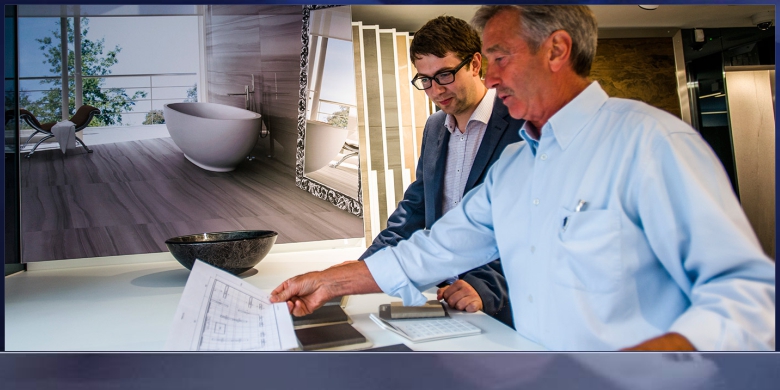“Without trust, your relationship does not exist; all you have is a series of transactions,” says Rosa Sheng, architect and senior associate at Bohlin Cywinski Jackson.
Trust is the foundation of any relationship between architect and client, and cultivating trust has huge benefits: repeat clients, patience when challenges arise, and referrals to new clients. But a weak or eroded sense of trust can harm your reputation, cost you future business, and even drive clients toward litigation.
Due to the complex nature of architecture projects, a number of factors can make or break an architect-client relationship. Here are seven tips from architectural experts to help you build and maintain trust.

1. Have an Effective Online Presence.
The first way to build a client’s trust—before you ever meet in person—is with your online presence. An unsubstantial or outdated online presence can be a red flag for prospective clients, so keep your website and professional profiles (including LinkedIn) updated with information about your firm and projects. “How is the client supposed to build trust if they look you up and can’t find anything about you?” Sheng asks.
2. Communicate Well Consistently.
Good communication is the cornerstone of building trust. “We get lost in the design process, and then we forget to communicate what’s happening and how it’s happening in an effective way and on a regular basis,” Sheng says. A regular check-in can bring potential problems to the surface early in the process and show the client you’re fully engaged.
Communicating your design intent to clients in a language your clients can understand is also essential to building trust. Make sure you don’t use “archispeak”—words such as “parti” and “trombe wall.” Architects often assume that clients can read drawings well and share the same technical vocabulary, which is usually not the case.
3. Show Your Vision With BIM.
Using 3D-modeling software like BIM, you can convey design and site-planning concepts via virtual walk-throughs and visualizations, leaving little room for clients to misinterpret your designs. This process also allows you to anticipate conflicts that may come up in construction with more accuracy so you can solve problems and reduce change orders.
“With BIM, you can go in with a wider array of tools and answer questions that would never have come up if you were just looking at 2D plans,” says Philip Noland, design visualization artist and owner of Noland Design Studio. “It brings about new exploration. The questions aren’t glazed over—they’re really looked at.”
For architect Lionel Scharly from Scharly Designer Studio, using BIM visualizations instills trust because clients can see the whole picture. “The more the client has details of the project, the better they understand, the more you accumulate their trust,” he says. “They are the ones paying, but they often don’t have a background in architecture, yet they want to be ‘in the project.”
4. Don’t Overpromise.
One of the most fundamental ways to build trust is to deliver what you’ve committed to doing. “The fear of saying no is rampant in our industry,” Sheng says. It’s especially hard to say no when it’s a down market and architects are starved for work. But in the long run, when you’ve said yes to something you can’t deliver just to get a job, your client will stop trusting you.
To avoid biting off more than you can chew, talk your clients through their project goals to confirm what they want can be done. “If it passes the three-question challenge, then it might be okay,” Sheng says. “Ask about the desired goal in three different ways—with a focus on design, budget, and schedule—to make sure they thought through their idea.”
5. Do Your Homework.
Designing a building entails a lot of moving parts. It’s important that you do your homework on factors such as applicable codes, the properties of materials you want to use, and what things cost. Clients rely on architects to be the experts in many arenas, and by doing your homework, you will convey the correct information and make fewer mistakes. “You definitely have to know what you’re talking about, so when you tell the client something, always double-check that it is accurate,” Sheng says.
6. Be Honest in Setting Expectations.
If you discover a problem, it may be tempting to cave to your client to curry favor. For example, if you learn the project will cost more than the client can afford, it’s important to deliver the message without wavering—even if the client pushes back. “There’s an expectation for an architect to push the boundaries, be innovative, and stretch the dollar, but the architect still needs to be financially responsible,” Sheng says. “Show conviction and maintain integrity in your professional expertise. Trust is built on consistency.”
Clients may also have unrealistic demands to squeeze the budget and schedule, and it’s your job to be honest about what’s feasible. “Sometimes the truth is hard to swallow, and in some cases, we lose out,” Sheng says. “But in the long term, the client realizes that you were right, and the truth prevails.”
Being up front about cost and viability can also prevent you from absorbing costs outside your initial scope, which can negatively impact your profit margin on the project.
7. Offer New and Creative Solutions.
When trust is lost due to a mistake or failed promise, it may take a long time to re-establish it. The best way to regain trust is to acknowledge where you went wrong, apologize, and offer solutions.
A contract BIM manager in the Facilities Management Group at Carolinas HealthCare System, Meghan Ruffo regularly collaborates with architects. For her, defaulting to problem solving within a linear 2D process—design, then engineer, then build—can erode confidence. “The willingness to think about how to solve the problem is important, rather than relying on the traditional approach or what an architect has always done in specific scenarios in the past,” she says.
For Sheng, creative problem solving is particularly important when the stakes are high: “Because construction is such a costly endeavor, costing hundreds of thousands or millions of dollars, it is a huge responsibility for architects to be the steward of that kind of money in the form of a building.”
Source: Redshift by Autodesk / Written By: Taz Khatri


